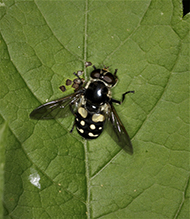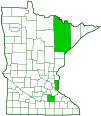White-spotted pond fly
(Sericomyia lata)
Conservation • Description • Habitat • Ecology • Distribution • Taxonomy
|
|
||||||||||||||
Description |
White-spotted pond fly is a robust, medium-sized, ⅝″ long hoverfly. It is somewhat bee-like in appearance. It is found across southern Canada and in the United States from New England to Minnesota. The face is short, projecting less than half the length of the compound eye below the compound eye. It is entirely yellow and does not have a black vertical stripe down the middle. There are two large compound eyes and three very small simple eyes (ocelli). The compound eyes are bare, without a covering of hairs. On the male they meet at the top of the head. On the female they do not. The ocelli are arranged in a small triangle at the top of the head. The antennae are short, no more than one-third the length of the face. There is a long bristle (arista) on the third segment of each antenna. It is about one and a half times as long as the antenna and has many fine filaments giving it a feathery appearance (plumose). The thorax is slightly wider than long. It is black tinged with bronze, shiny, and unmarked. The plate between the abdomen and thorax (scutellum) is large, convex, and colored like the thorax. The scutellum has a fringe of long pale hairs. The abdomen is oval and slightly longer than wide. It is black with pairs yellow marks on the second, third, and fourth segments. The yellow marks do not touch the lateral margin. The marks on the second abdominal segment are large and nearly round. Those on the third segment are smaller and separated in the middle, effectively two spots on each side. The marks on the fourth segment are even smaller, kidney-shaped, and placed at an oblique angle. The tip of the abdomen is sometimes reddish. The wings are clear. The second cell on the leading edge of each wing toward the tip (pterostigma) is relatively broad and tinted brown. It does not have a cross vein. The marginal cell (R1) is open. The legs do not have spurs. The third leg segment (femur) is not thickened. |
Size |
Total length: ⅝″ |
Similar Species |
Habitat |
|
Ecology |
Season |
|
Behavior |
|
Life Cycle |
|
Larva Food |
Larvae filter pond water of decaying organic debris, obtaining nourishment from microorganisms. |
Adult Food |
|
Distribution |
||
|
Sources |
|
| 8/19/2025 | ||
Occurrence |
||
|
||
Taxonomy |
|
Order |
|
Suborder |
Brachycera |
Infraorder |
Cyclorrhapha |
Zoosection |
Aschiza |
Family |
Syrphidae (Hover Flies) |
Subfamily |
Eristalinae (Drone Flies and Allies) |
Tribe |
Milesiini |
Subtribe |
Sericomyiina |
Genus |
Sericomyia (pond flies) |
Subgenus |
Sericomyia |
Subordinate Taxa |
|
|
|
Synonyms |
|
Condidea lata |
|
Common Names |
|
white-spotted pond fly |
|
Glossary
Arista
A large bristle on the upper side of the third segment of the antenna of a fly. Plural: aristae.
Femur
On insects and arachnids, the third, largest, most robust segment of the leg, coming immediately before the tibia. On humans, the thigh bone.
Ocellus
Simple eye; an eye with a single lens. Plural: ocelli.
Pterostigma
The dark, blood-filled second cell at the leading edge of each wing toward the tip on many insects. It is heaver than adjacent, similar sized areas and is thought to dampen wing vibrations and signal mates. (= stigma. More precise than stigma but less often used, even by entomologists.)
Scutellum
The exoskeletal plate covering the rearward (posterior) part of the middle segment of the thorax in some insects. In Coleoptera, Hemiptera, and Homoptera, the dorsal, often triangular plate behind the pronotum and between the bases of the front wings. In Diptera, the exoskeletal plate between the abdomen and the thorax.
Visitor Photos |
||
Share your photo of this insect. |
||
This button not working for you? |
||
Alfredo Colon |
 |
MinnesotaSeasons.com Photos |
||
|
||
|
||

Slideshows |
|

Visitor Videos |
||
Share your video of this insect. |
||
This button not working for you? |
||
|
Other Videos |
||
|

Created: 10/19/2018 Last Updated: © MinnesotaSeasons.com. All rights reserved. |


